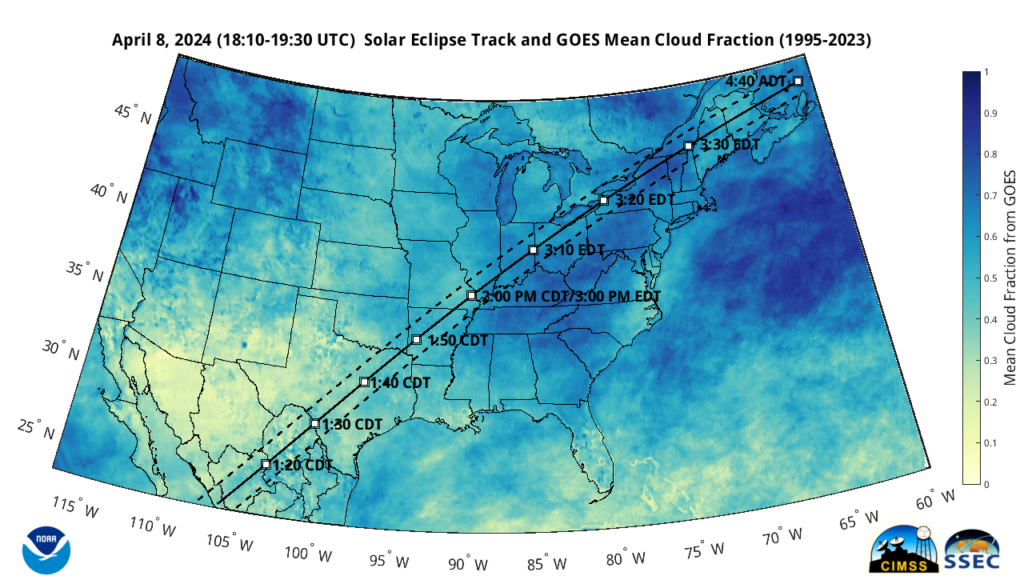Updating GOES Cloud Climatology for the April 8, 2024 Total Solar Eclipse
By now you probably already know that a total solar eclipse will traverse North America during the afternoon of April 8, 2024. There have been many stories in the media and previous blog entries here at the CIMSS Satellite Blog: Will it be Cloudy on April 8th (2024)? and GOES Cloud Climatology on April 8th.
The Washington Post liked our previous GOES cloud climatology image so much they created their own version from our data and of course it looks fantastic! They know how to make good science look good! Please check out their story. Thank you to the Washington Post’s Lauren Tierney for reaching out to us and highlighting the work of the CIMSS cloud science team.
This presented an opportunity to update our GOES climatology figure. Enterprise Cloud Products were produced using NOAA’s Clouds from AVHRR Extended (CLAVR-x) processing framework at the University of Wisconsin, CIMSS. It turns out we have data that covers part of Atlantic Canada. New Brunswick and Nova Scotia to be specific, mostly cut out of the previous version unfortunately. One of the primary goals of the CIMSS Satellite Blog is to educate people and we usually learn new things along the way. For example, the author recently learned about the Atlantic Time Zone (note the final time marked on the map is in Atlantic Daylight Time or ADT). This also prompted the author to figure out how to put Canadian Province and Mexican State borders on maps in Matlab, so we can help our neighbors a bit.

Some people have expressed an interest in seeing these climatology data with a prettier color enhancement. The Washington Post version is really fantastic, but here’s the same data with a progressive colormap:

Notice the totality part of the eclipse goes by pretty fast, from the Pacific Ocean, across Mexico, across the contiguous USA, and past Canada into the Atlantic Ocean in about 25-30 minutes! It also will pass right over Newfoundland, which unfortunately is outside the coverage area of our data. For any given location, totality only lasts a few minutes though the eclipse event is much longer than that. The National Centers for Environmental Information (NCEI) has an eclipse page with an interactive map from which you can get both their cloud climate analysis and the time/duration of the eclipse for many towns and cities in the USA (it’s not helpful for our neighbors). Our friends in Canada are getting ready too of course and you can find more information about viewing the eclipse in Canada from Dan Falk (@danfalk on X) and this neat YouTube video he made. Mexico seems likely to get the best cloud-free views and also the spot with the longest view of totality. For our Spanish speaking audience, you can learn more about the eclipse and what to expect in Mexico (probably clear skies! Longer duration eclipse) from this UnoTV YouTube video featuring Primoz Kajdic of Universidad Nacional Autonoma de Mexico.
You might be wondering what the difference is between our cloud climatology product and the NCEI one or any others you might see on the web? Ours is generated solely from GOES observations, a few hours from every April 8 from 1995-2023 and averaged. Some other cloud climatologies may include satellite observations, some do not, and some include other satellite platforms.
Going to see the eclipse? Remember to be safe! Don’t look at the sun directly without suitable eye protection! You maybe can get away with it during totality, but remember it doesn’t last long and ends rather suddenly. Let the SUVI stare at the sun, it’s built for that! Follow NASA’s safety guidelines.
Disclaimer on cloud climatology: this is not a real forecast and past clear or cloudy skies do not guarantee anything for April 8, 2024! You should check your local forecasts which are probably starting to get pretty accurate for clouds around April 6 and will be most accurate the morning of the eclipse. The eclipse itself can impact the amount of certain types of clouds. Most local meteorologists along the path are going to be paying attention to cloud cover, where good open places to view it will be, and what local plans are for schools, parks, etc. Be safe traveling to your view area!
Don’t miss it if you can help it! While partial solar eclipses are not too rare, total solar eclipses that go through your country are. For most of us in the U.S., it’s going to be a long time before we see another one. Alaska will see one in March 2033. Montana and North Dakota will see one in August 2044. The rest of the lower 48 will have to wait until August 2045 when an eclipse will traverse the contiguous U.S. from Florida to California. NASA has more information about future and past eclipses.
Finally, if you can’t see the eclipse, don’t fret. The web will be full of pictures from those who get the best cloud-free views. Check back here at the CIMSS blog where we will post animations of GOES ABI imagery of the shadow crossing CONUS and hopefully some SUVI animations of the full eclipse. We enjoy making images of solar eclipse shadows! For fun, here’s what an eclipse in 1984 with a similar, but more southern, path looked like from GOES-5:
Thanks to Frank Espenak of NASA Goddard Space Flight Center (GSFC) for the prediction data on the eclipse path, including times.
—————
Free Secure Email – Transcom Sigma
Transcom Hosting
Transcom Premium Domains
